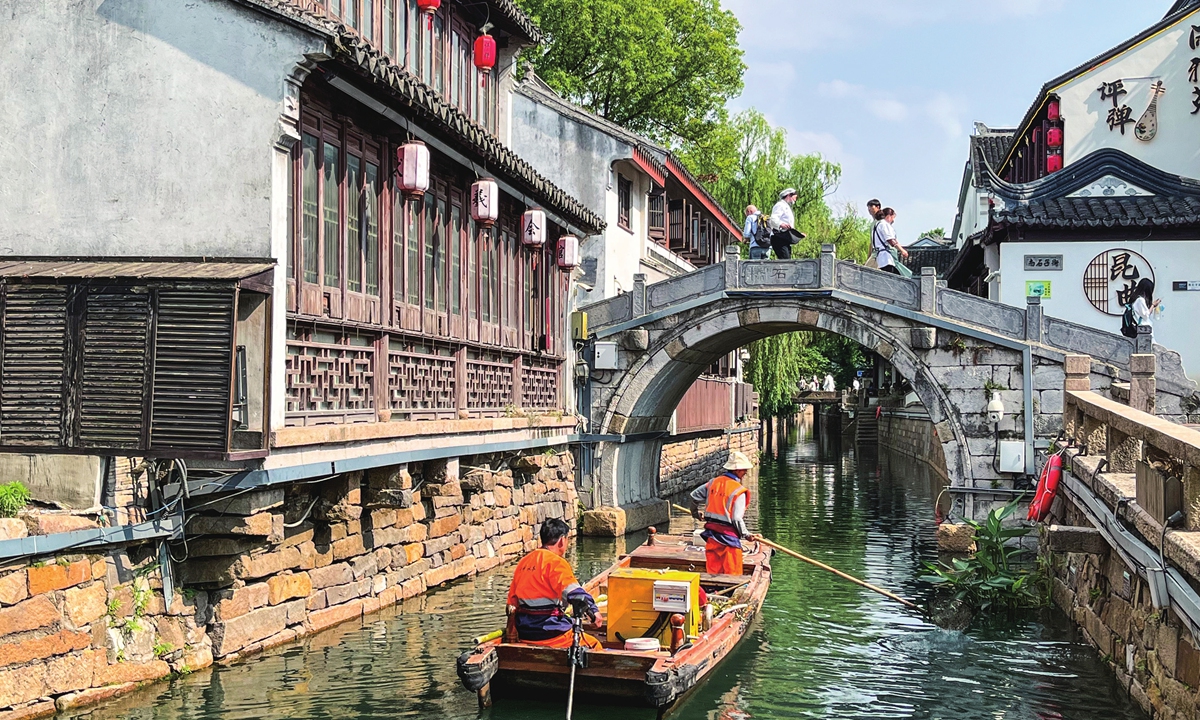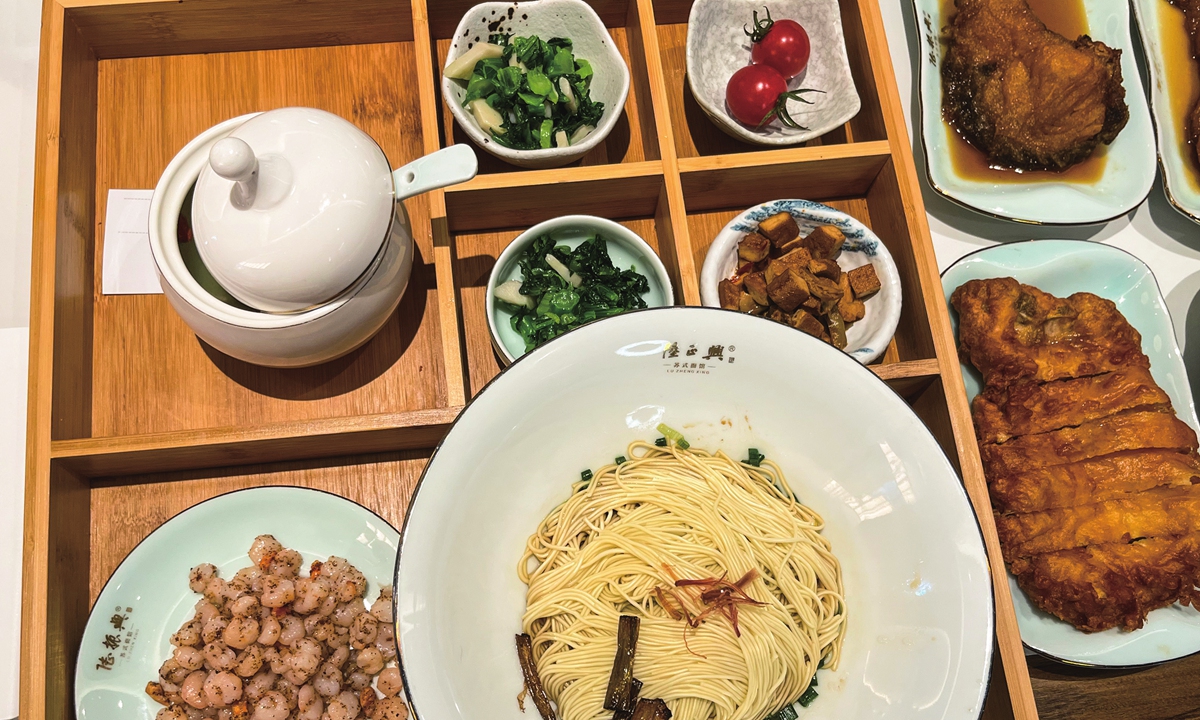
Pingjiang Road, a historical street dated back to the Song Dynasty (960-1279) in Suzhou Photo:Xu Liuliu/GT

Su-style noodle, a typical Suzhou dish special for its delicious toppings Photo:Xu Liuliu/GT
A well-known Chinese proverb goes: "Above there is heaven and below there are Suzhou and Hangzhou." Heaven can be very far and beyond our reach, but Suzhou in East China's Jiangsu Province is very close especially thanks to China's convenient and fast high-speed bullet trains.
After only a four-hour ride from Beijing, we can take a closer look at this "heaven on earth," with its amazing gardens, streets characterized by classical Chinese architecture, ancient towns, Kunqu opera and more. Listed as a UNESCO world heritage, the classic Chinese gardens of Suzhou have been the top choice of travelers.
Lingering beauty Dating from the 11th to the 19th century, Suzhou gardens reflect the profound metaphysical importance of natural beauty in Chinese culture with their meticulous designs.
No one could resist such beauty and creative designs, not even the emperors. Emperors Kangxi and Qianlong of the Qing Dynasty (1644-1911) each visited Jiangnan, or Southern China, six times who stayed at these gardens.
The classical gardens of Suzhou date back to the 6th century BC, when the city was founded as the capital of the State of Wu during the Spring and Autumn Period (770BC-476BC).
Inspired by these royal hunting gardens built by the King of the State of Wu, private gardens began emerging around the 4th century and finally reached the climax in the 18th century.
Today, more than 50 of these gardens are still in existence, nine of which, including the Humble Administrator's Garden, Lingering Garden, Net Master's Garden, the Mountain Villa with Embracing Beauty, are regarded as the finest embodiments of Chinese "Mountain and Water" gardens. Each garden among these nine displays its own unique traits and design and they are all worth the time to visit and enjoy some leisure time there. I personally chose the Lingering Garden, or Liuyuan, to peek into these classical gardens, thus avoiding the crowds of tourists.
Originally this was a garden used by scholars, originally known as the East Garden and rather smaller than others.
The garden can be entered through a narrow passage, only 50 meters in length, which leads to views of the lake through brilliant grilled windows. The path then leads to a roofed walkway bordering the lake.
The architectural structures divide the garden into four sections: the East Garden, the Central Garden, the West Garden, and the North Garden.
The striking architecture, perfectly combined corridors, artificial hills, rocks and water features can amaze every visitor.
The design of the garden realizes the concept of recreating exquisite landscapes within limited spaces.
This materializes in what is known as: "A Different View For Each Step" and it displays perfectly an elegant intellectual aesthetic.
As an excellent representative of the aesthetic of intellectuals, every building in the garden has a beautiful, poetic name inspired by famous ancient poems or articles.
Another highlight comes from its brilliant use of beautiful natural stones from the Taihu Lake, a valuable decorative material in Chinese culture.
The tallest rockery Guan Yun Feng (Cloud-Capped Peak) is 6.5 meters high and is also the tallest in the Suzhou gardens.
Spending a morning wandering between these buildings and the landscapes is something that was once only enjoyed by China's wealthy intellectuals.
Walk in a water ink To explore the historical traces and ordinary people's life of such an ancient city, you can move to the Pingjiang Road, a historical street not far from the Lingering Garden.
The 1,606-meter-long road has been recorded in history as early as the Song Dynasty (960-1279).
On the map of Suzhou ancient city in Song Dynasty, the Pingjiang Road was regarded as the main road. After 800 years, Pingjiang Road is still very well-preserved as a stone route with a river flowing along it.
The area often shows what traditional Suzhou local life is supposed to have looked like: Bridges across the river, houses with white walls and black roofs built along the stone road, locals, especially the old, walking leisurely.
The place seems frozen in time and offers a great scene for traditional Chinese painting.
Walking on the road, one feels like traveling in time to hundreds of years ago during the Song Dynasty when the road was already paved as it is today, the river was still green and clear and residents populate the area as they used to during the Song Dynasty.
Among the bridges there is one called Cake Bridge because of a moving story about a man and his love for his mother.
More to explore As one of the most well-known cities in China, Suzhou not only is a treasure trove of cultural assets such as the Hanshan Temple in Fengqiao Town, west of Suzhou, the pingtan, a genre of storytelling with ballad singing performed in Suzhou dialect, the taohuawu woodcut, the Suzhou Museum, a masterpiece by world famous architect I.M.Pei as well as the Jinji Lake in the central part of Suzhou Industrial Park.
As a foodie, I deeply appreciate Suzhou's emphasis on fresh, subtly sweet flavors and an attractive presentation, especially for the Su-style noodles. A traditional food dish in Suzhou, it is a combination of soup, noodles and toppings.
The toppings are so rich in variety that they almost cover all recipes of Suzhou cuisine, from pork ribs, to shrimps, to stir-fried meat.





